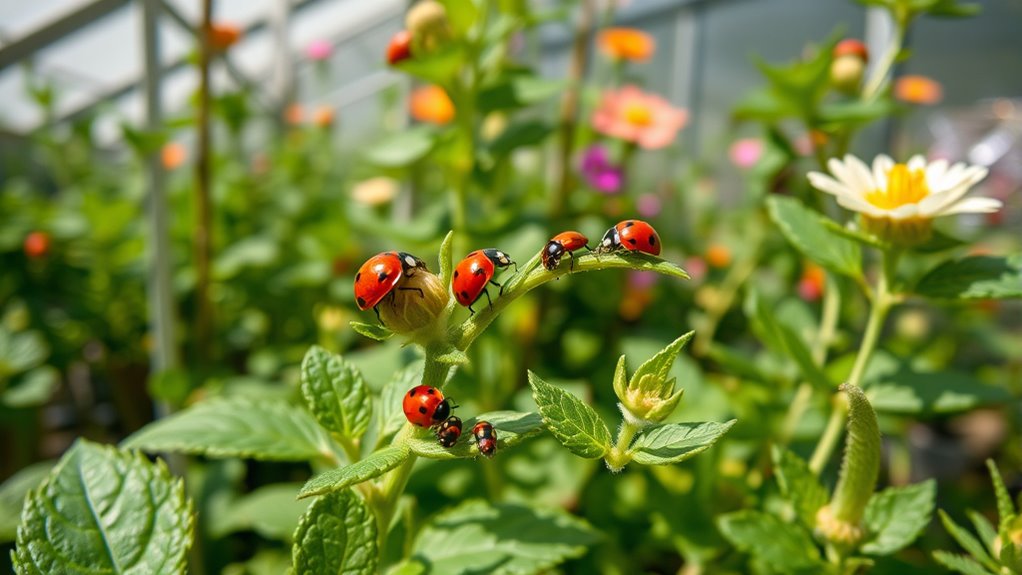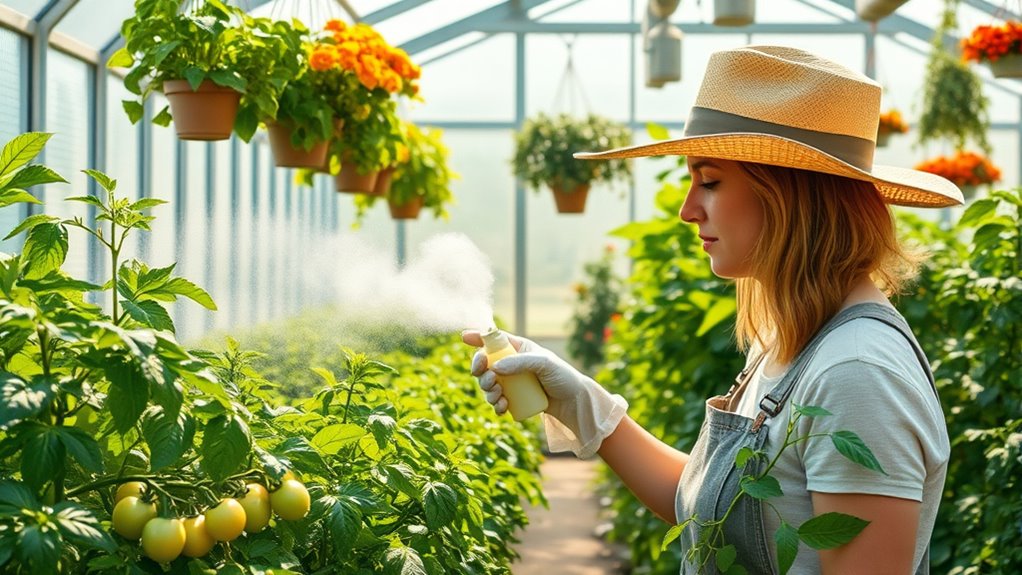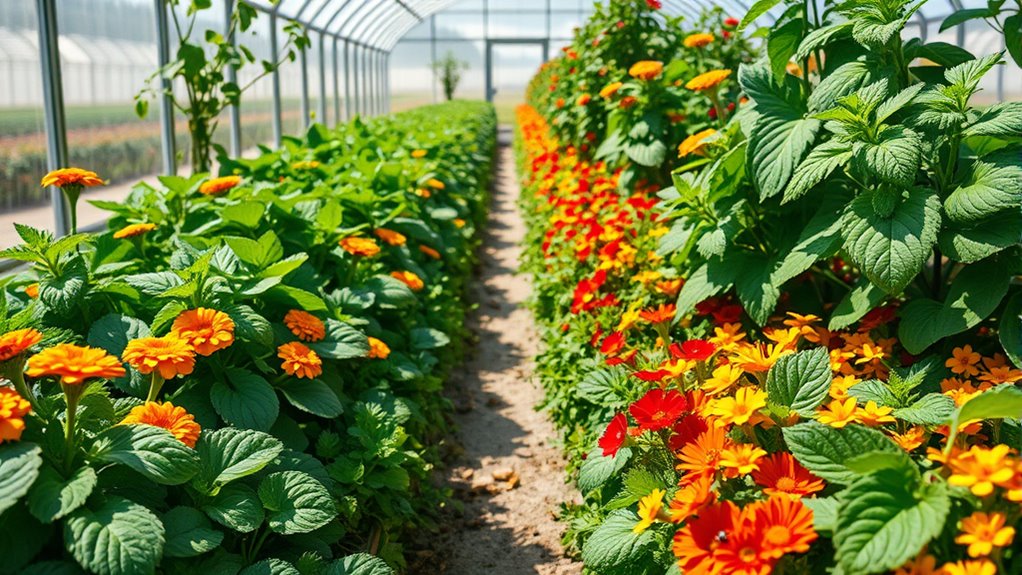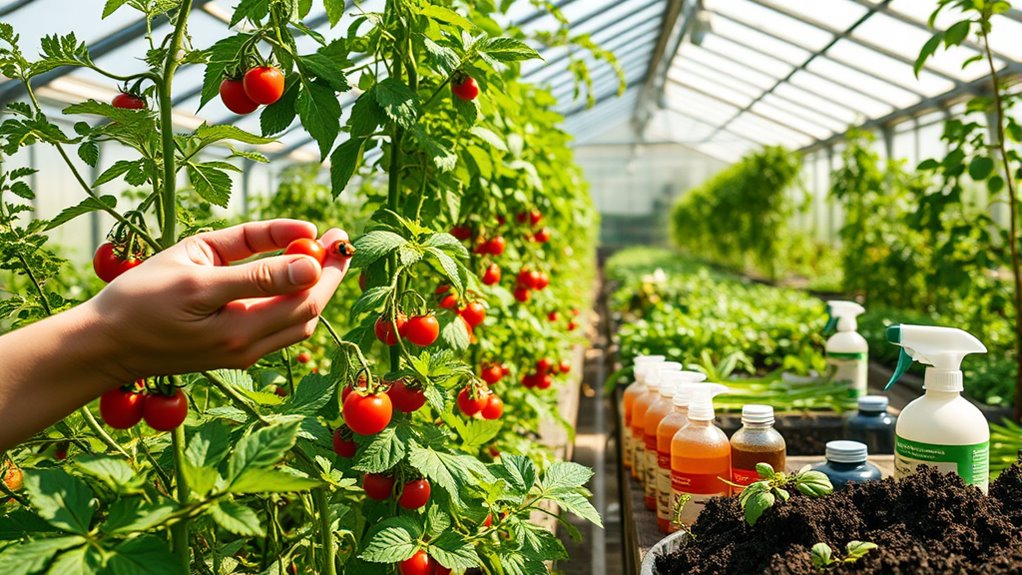To manage pests organically in your greenhouse, use beneficial insects like ladybugs and predatory mites to target specific pests naturally. Incorporate botanical pesticides such as neem or citrus oils, which break down safely and repel insects. Practice cultural controls like crop rotation and physical barriers, and consider companion planting to deter pests. Using homemade traps and pest-repelling plants adds extra layers of protection. Keep exploring these eco-friendly methods for a healthy, pest-free greenhouse environment.
Key Takeaways
- Introduce beneficial insects like ladybugs and predatory mites to naturally reduce pest populations.
- Use organic botanical pesticides such as neem or citrus oils to target pests safely and effectively.
- Implement cultural controls like crop rotation and soil health practices to disrupt pest life cycles.
- Employ companion planting with pest-repelling plants like marigolds and basil to deter insects naturally.
- Utilize homemade traps and physical barriers to capture or block pests without chemical inputs.
Beneficial Insects and Predators

Beneficial insects and predators play an essential role in organic pest control by naturally reducing pest populations. You can encourage this process through predator release, where you introduce beneficial bugs directly into your greenhouse. These beneficial bugs target specific pests, such as aphids or whiteflies, helping keep their numbers in check without chemicals. By releasing predators at the right time and in appropriate quantities, you create a balanced ecosystem that minimizes pest outbreaks. Not only does this method reduce reliance on synthetic pesticides, but it also promotes a healthier environment for your plants. Regularly monitor pest levels to determine the best moments for predator release. Additionally, understanding pest behavior and environmental factors can improve the effectiveness of biological control methods. Incorporating mindfulness techniques in your gardening routine can also help you stay attentive to subtle changes in plant health, enhancing pest management efforts. With a strategic approach, beneficial insects become your natural allies in maintaining pest-free, thriving plants.
Organic Botanical Pesticides

Organic botanical pesticides are a natural and effective way to control pests without relying on synthetic chemicals. These pesticides use botanical extracts and plant-based oils to target pests while being safe for your greenhouse environment.
When applying botanical extracts, imagine a thin, fragrant film covering pests, disrupting their feeding and reproduction. Plant-based oils, like neem or citrus oil, work by suffocating or repelling insects, creating a protective barrier. These oils can also reduce pest populations effectively when used properly. Incorporating organic pest management techniques can further enhance pest control efforts and promote sustainability. Additionally, botanical pesticides are biodegradable, breaking down naturally without polluting the environment.
You might notice a mist of aromatic oils settling on leaves, with a smell that’s both fresh and herbal. These botanical pesticides are versatile, easy to use, and biodegradable, making them ideal for organic greenhouse management. Incorporating integrated pest management strategies alongside botanical pesticides can enhance their effectiveness and promote a healthier growing environment.
Incorporate them into your pest control routine for a safer, eco-friendly approach that respects your plants and the environment.
Cultural and Mechanical Controls

Have you considered how cultural and mechanical controls can effectively reduce pest populations without chemicals? These methods focus on improving soil health and using practices like crop rotation to disrupt pest life cycles. By rotating crops, you prevent pests from establishing strongholds, keeping populations in check naturally. Mechanical controls, like traps or physical barriers, directly remove or block pests from plants. These strategies minimize pest pressure and promote healthier plants. Additionally, emerging sustainable techniques can play a role in encouraging farmers to adopt environmentally friendly practices. Understanding integrated pest management principles can enhance the effectiveness of these methods. Incorporating soil health practices can further support pest suppression and plant resilience. Maintaining soil quality through organic matter addition helps create a hostile environment for pests and encourages beneficial organisms. Here’s a quick comparison:
| Cultural Controls | Mechanical Controls |
|---|---|
| Crop rotation | Traps and barriers |
| Soil health practices | Handpicking pests |
| Proper watering | Sticky traps |
| Sanitation | Physical removal |
| Adjusting planting times | Screens and covers |
Together, they create a sustainable approach to pest management.
Companion Planting Strategies

Companion planting leverages the natural relationships between plants to deter pests and promote healthy growth. By choosing the right plant pairing, you can create a pest deterrent effect that reduces the need for chemical controls. Incorporating data-driven marketing strategies such as observing pest patterns and plant responses can optimize your companion planting success. Imagine lush green rows where marigolds surround your tomatoes, their scent repelling nematodes. Basil planted near peppers confuses pests and enhances flavor. Nasturtiums act as a trap crop, attracting aphids away from your main crops. Sunflowers serve as a visual barrier, distracting insects from delicate plants. These strategies work by harnessing natural plant interactions, making your greenhouse a thriving, pest-resistant environment. Additionally, understanding relationship dynamics between plants can help you adjust your pairing choices for even better pest control outcomes. Exploring plant compatibility can further inform your selections and improve pest management. Incorporating organic pest control methods like beneficial insects or natural repellents can further enhance your pest management plan. Recognizing the importance of plant selection in companion planting ensures that each pairing maximizes pest deterrence and plant health. With thoughtful plant pairing, you encourage healthy growth while minimizing pest problems—an essential part of organic pest control.
Natural Repellents and Traps

Natural repellents and traps are effective tools for keeping pests at bay without chemicals. You can use natural repellent plants like marigolds, basil, and mint to deter insects naturally. Additionally, homemade traps can target specific pests; for example, sticky traps catch flying insects, and baited jars attract crawling pests. These methods are simple, eco-friendly, and cost-effective. Incorporating appropriate plant selection can further enhance pest control efforts in your greenhouse. Using pest management techniques aligned with organic principles ensures a safer environment for your plants and beneficial insects. Understanding market fluctuations and adjusting your strategies accordingly can improve your pest control outcomes and protect your crops more effectively. Employing integrated pest management strategies can optimize your results and maintain ecological balance within your greenhouse.
Frequently Asked Questions
Are Organic Pest Controls Safe for All Greenhouse Plants?
You might wonder if organic pest controls are safe for all greenhouse plants. Generally, they support plant health without harmful chemicals.
However, some treatments could affect sensitive plants or cause pest resistance if overused. Always follow label directions, monitor plant responses, and rotate methods to maintain pest resistance.
This approach helps protect your plants’ health while minimizing risks, ensuring your greenhouse thrives with healthy, pest-free plants.
How Often Should Organic Treatments Be Reapplied?
You should reapply organic treatments based on your plants’ needs and pest activity levels. Establish clear timing schedules and treatment intervals, typically every 7 to 14 days, but adjust as necessary.
Monitor your greenhouse regularly for signs of pests or damage, and reapply when new infestations appear or after heavy rain.
Consistently following your schedule helps keep pests under control without overusing treatments.
Can Organic Methods Eradicate All Greenhouse Pests?
Think of pests like a stubborn weed in your garden—organic methods can weaken them, but rarely eradicate every seed. While natural controls can manage pests, chemical resistance may develop, making some tougher to eliminate.
Pest resurgence is also possible if you don’t stay vigilant. So, no, organic methods rarely wipe out all greenhouse pests entirely, but they’re effective for long-term, eco-friendly pest management when combined with monitoring and timely interventions.
What Are the Costs Associated With Organic Pest Control?
When considering costs, you’ll find that organic pest control methods often have a higher initial expense compared to chemical options.
You should do a cost comparison, factoring in the labor requirements, as organic methods typically need more frequent application and monitoring.
While the upfront costs might be higher, you benefit from eco-friendly, sustainable pest management that aligns with organic farming goals, potentially reducing long-term expenses and environmental impact.
Do Organic Methods Impact Greenhouse Produce Yield?
You might worry that organic methods lower your greenhouse yield, but they actually improve pest resistance and organic longevity. When you use natural controls, pests develop resistance more slowly, leading to healthier plants over time.
This sustainable approach encourages consistent yields without harmful chemicals, ensuring your produce remains vibrant and abundant. Organic pest control methods support long-term productivity, so you can enjoy steady harvests while protecting your environment.
Conclusion
By incorporating beneficial insects, organic pesticides, and strategic planting, you can effectively manage pests in your greenhouse without chemicals. For example, imagine releasing ladybugs to control aphids; you see fewer pests and healthier plants. These methods create a sustainable, eco-friendly environment that boosts plant health and yields. Embrace these practices, and you’ll enjoy a thriving greenhouse that’s safe for both your plants and the planet.









